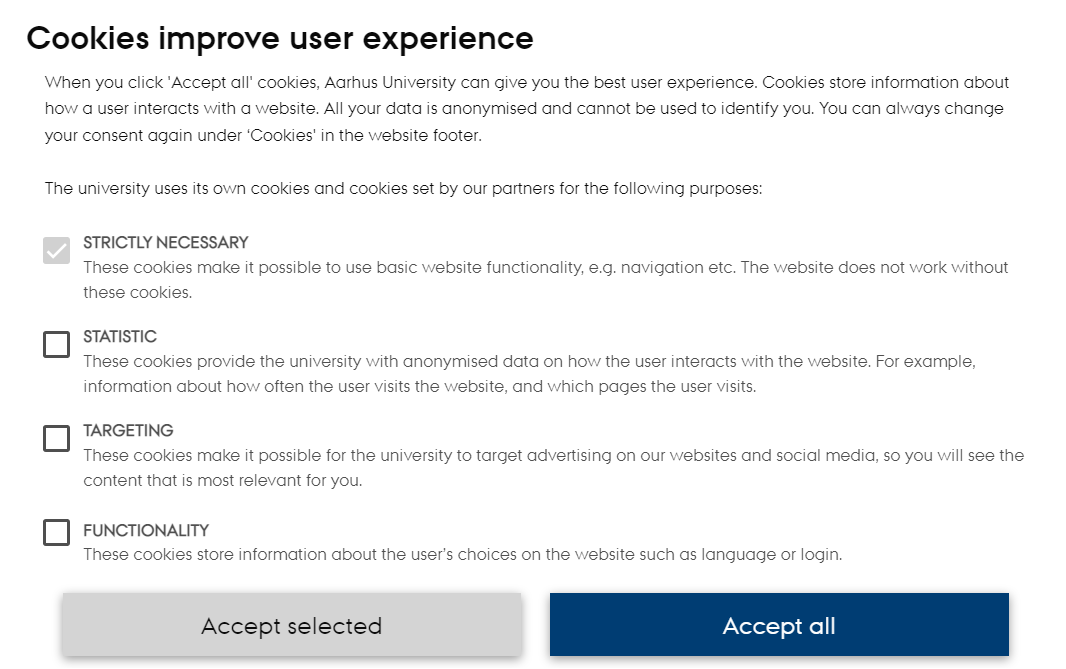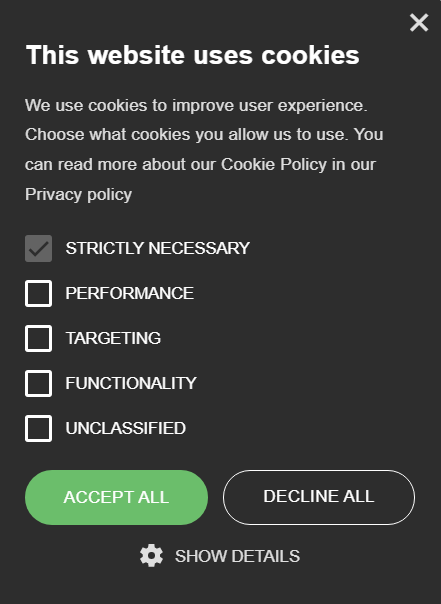ON THIS PAGE
- What is a Cookie Banner?
- What is the Purpose of a Cookie Consent Banner?
- Do I Need a Cookie Banner on My Website?
- Multilingual Cookie Banner
- Geo-targeting of a cookie banner
- Checklist for Creating a Cookie Consent Banner
- What if I don’t have a Cookie Consent Banner?
- Do I need a cookie policy on my website?
- Looking for a Solution?
- Frequently asked questions
We’re all familiar with those pop-ups on websites that alert us to cookies being present and asking for consent to use them. Such privacy popup is now located on most of the websites worldwide and for sure many people will either click ‘accept' or 'decline' without giving it a second thought.
The reason a cookie banner has become so common is due to the European Union and other governments require Cookie Consent on websites that use them.
In this article, CookieScript will help you understand the purpose of a consent banner and why you should have one on your website — even if you don’t have a physical presence in the EU.
What is a Cookie Banner?
A cookie banner is a notice board that pops up the first time you visit a particular website. Such privacy popup is used to inform their readers about the trackers the site uses and even give options for customers to choose what cookies would they like to be stored on their devices.

CookieScript banner example
It is important to notice that such a Cookie Consent popup should also provide additional information on what data is going to be collected, so the visitors are aware of the purpose of your notice.
What is the Purpose of a Cookie Consent Banner?
A cookie notice is designed to warn visitors that your website uses cookies and also gives visitors the option to either give consent or decline them. Depending on whether the website is conducting business, the banner may also offer additional options and disclosures.
A cookie banner should do three things:
- Alert visitors that the website uses cookies.
- Give visitors a chance to opt-in/opt-out.
- Link to further details on cookie policies and a means to adjust settings.
Do I Need a Cookie Banner on My Website?
If you have a website that operates from the European Union or that targets citizens of the EU, you are required to have users' consent before deploying cookies.
The first step of this is to have a cookie disclaimer in place. Having it on your website helps to not only avoid fines and other penalties but helps build trust with your visitors.
You should have a disclaimer in place if:
- You operate from the European Union
- You have customers in the EU
What if your only customers are in the United States? The California Consumer Privacy Act (CCPA) requires businesses to inform users of how their data is collected and used. So, an opt-out cookie banner is required. Websites should also have a "Do Not Sell my Personal Information" button to allow consumers to opt-out of the sale of their Personal Information.
The Virginia Consumer Data Protection Act (VCDPA) went into effect on January 1, 2023.
Colorado Privacy Act (CPA) will go into effect on July 1, 2023.
The other states of the USA have their personal data privacy acts in various legislative processes, and more data privacy laws are expected to come into force in a near future.
Multilingual Cookie Banner
If you have a multilingual website, you could have different cookie banners in different languages. Add translations for any additional languages besides the default language. See the guide on how to add new translations.
CookieScript will detect the language, used by the website user, and the right cookie banner will be shown on the website. See the guide on language detection for a cookie banner.
Geo-targeting of a cookie banner
Many countries and US states have different privacy regulations with different requirements for the Cookie Banner and cookie control, so different cookie banners are needed. In order to meet our client's demand, we have created a feature that allows you to select visitors from which countries should see your banner. You can select from 250 countries and 50 US states.
With the help of geo-targeting, you could also set it to show different cookie banners for different locations. For example, users from Italy would see the cookie banner in Italian, and users from Spain- in Spanish. Read more about geo-targeting and how to set up geo-targeting to set up geo-targeting with several banners.
Checklist for Creating a Cookie Consent Banner
To help you comply with the General Data Protection Regulation (GDPR), European Privacy Directive (ePR), and other laws, your EU cookie banner should provide the following:
- Small or large pop-up banner to let visitors know that the website uses cookies.
- A brief explanation of how the website uses them and whether this information is shared with third parties.
- Options to either opt-in or opt-out.
To comply with the GDPR and ePR, you should also have a Data Protection Officer (DPO). The DPO's role is to maintain records of consent and respond to user requests. The DPO will also oversee consent withdrawal and record deletion requests. Read the full GDPR compliance checklist.
What if I don’t have a Cookie Consent Banner?
If you want to start a website for your business or product, you will need a compliance banner. Yes, there are ways to go without it, but just if your website uses only exempt cookies.
But in any other way, if your website is based in the EU or has EU users, straight away it falls under the GDPR requirements for cookie notice.
If you don’t have GDPR compliance with your banner, you could be in serious trouble. Potential fines can go up to 4% of your company’s yearly revenue. Read about the biggest GDPR fines so far.
With CCPA, it’s more or less the same. If your website is based in California and doesn’t have a cookie notice, you will receive a notice of alleged violations and you will have 30 days to repair the situation and get a consent popup.
If you fail to do so in the provided time, you can end up paying thousands of dollars in fines for intentional or non-intentional violations.
Of course, no one wants to experience such a financial crash, especially since the banner from CookieScript costs much less than a potential fine and is really easy to set up based on your needs.
Read the guide to find out if your cookie banner is GDPR compliant or CCPA compliant.
Do I need a cookie policy on my website?
In the EU, the GDPR and the ePrivacy Directive require websites to inform users about their data collection and management. As cookies are considered personal data, a Cookie Policy is required for websites, operating in the EU. A Cookie Policy could make part of a Privacy Policy.
The Privacy Policy must be easily accessible on every page of your website. It could be accessible via a link or through a cookie banner. It must also be written in clear language that is understandable by people.
In the US, CCPA also requires websites to have a Privacy Policy. Websites must disclose the collection and use of personal information through cookies.
Looking for a Solution?
CookieScript simplifies the process of remaining compliant with all the latest laws and regulations and allows you to modify your privacy popup in the way you want it to look – you can change the color scheme, buttons, and all the other features on the banner.

Example of a CookieScript banner
Not only can CookieScript help you remain compliant with the GDPR and CCPA, but it also offers its unique Privacy Policy Generator and automatic language detection. We also provide cookie list and generate a cookie declaration table.
CookieScript can even record visitor consent on your behalf and if you want to work independently, it also offers an opportunity to download and host the code yourself.
The geo-targeting feature of CookieScript determines your website user location and automatically presents the correct compliance solution.
Finally, every cookie banner is also optimized for various devices to give your visitors a user-friendly experience.
Frequently asked questions
How to make a Cookie Banner?
Making a cookie consent banner is a simple business if you choose CookieScript, which offers its customers all the tools to make their website comply with the latest privacy regulations. You just have to select a template, add content to it and select its positioning. Learn more here.
Does CCPA require a Cookie Banner?
Yes, if you have a website that runs in California or has visitors from it, you will need a privacy banner. Without it, there can be serious fines applied to your company since it’s not compliant with privacy laws. Click here to try the CookieScript banner for free.
Does GDPR require a Cookie Banner?
Under the EU’s GDPR law, your website must have a banner that lets your visitors know that you're using cookies and how are they being processed. It also should allow the visitors to opt-in/opt-out of cookie usage. Find out more here.
How to create a Cookie Banner?
For banner creation with CookieScript, there are simple steps to follow:
- Select a free or paid option that suits your needs
- Adjust the cookie disclaimer and its information
- Add CookieScript cookie consent banner to your website
What is a Cookie Banner?
A cookie banner is a small notice board that pops up the first time you visit a website. Such notice is used for websites to inform their readers about the trackers the site uses. Such a privacy popup gives options for customers to choose what cookies would they like to be stored on their devices. CookieScript offers such an opportunity too.
Do I need a Cookie Banner?
You will need a cookie consent banner if your website uses cookies and it is based in the EU, or it has visitors from the EU. If you use cookies, the GDPR requirements apply to you. Find out more about a GDPR compliant banner here.
Do I need a Cookie Banner for Google Analytics?
Since Google Analytics uses several cookies to track users, you will need a consent banner if you want to collect user consent in your website and comply with data privacy laws. Get it here.

